When for the first time I tried the Marshall Lead 12 mini stack and I discovered the fantastic sound that came out of it, like a real Marshall, I realized that Jim Marshall’s mosfet amps of the 80s really have something special. Something that really deserves not only the layout with which they are built, all to remember the big brother JCM 800, but also and above all the glorious name printed above!
So, like G.A.S. command, I certainly could not stop there! Actually 12 W are excellent at home, but I wanted something more powerful, so I bought the Marshall 3310, matching it with its 1931a and 1931b speakers. And then … the Marshall 3210, or even Lead 100, where 100 stands for power: 100 W.
Basically I was looking for the same sound, only, with 100W of power. Result obtained? Ni, in the sense: I sound great Marshall as I wanted, but different from the other two.
Features
The Marshall 3210 is a mosfet head produced in the 1980s, featuring two channels (one clean and one distorted), a master volume and a master reverb. The clean channel has the classic equalization, with adjustments for highs, mids and lows, and the volume adjustment (which works more or less like a preamp). The distorted channel only has adjustments for tone, volume and gain.
But here are two major differences between the Marshall 3210 and other mosfet amplifiers in the same series, or, as far as I know, even any other amplifier. First of all, the gain potentiometer of the distorted channel is of the push-pull type, which is used to activate a power boost. The second difference is that, in the absence of the footswitch (which controls both the activation of the reverb and the passage from the clean to the distorted channel, and vice versa) inserted, the clean and distorted channels are mixed!
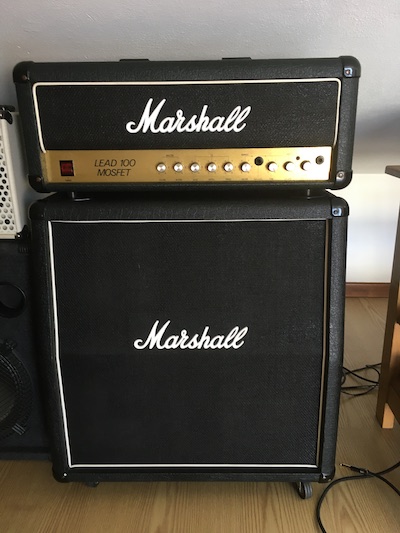
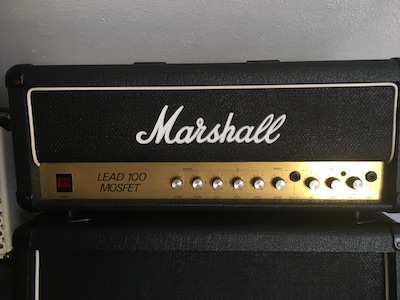
If you don’t want to make the two channels mix and you don’t have a footswitch, just insert a jack into the input of the pedal without inserting it completely: inserting it completely activates the distorted channel, otherwise , if placed halfway, the clean channel.
On the back we have the inevitable send and return, a line out with a lot of output level adjustment, and outputs for two 4/16 Ohm speakers.
The case is a Marshall 1965a, flared, with 4 Celestion G10L-35 cones, which in my opinion is excellent. First of all it’s extremely light compared to my Marhsall 1960a 4×12, but it also has a nice midrange shot which always helps.
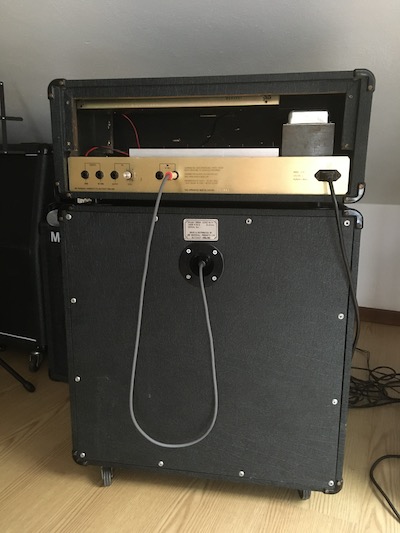
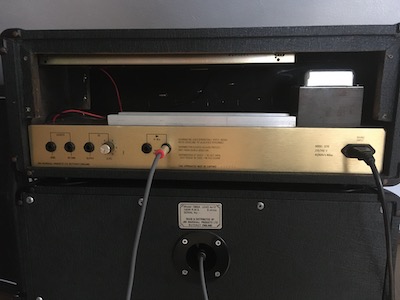
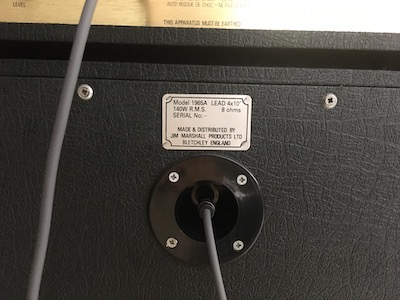
Sound
Here’s the key point: How does the Marshall Lead 100 sound?
The clean channel is fantastic, crystal clear, with a devastating attack. The sound is clear, when compared with the Marshall 3310 which is much richer in bass. But be careful, it doesn’t mean it’s thin or poor, it’s a really massive sound, just very rich in highs and ringing. In this it is more reminiscent of the Marshall Lead 12 3005 stack. It’s a perfect sound for those clean crystalline Marshalls that make a guitar twang with single coils, but also some Gibsons.
Put pedals in front of it to create a distorted sound and you have a really great amp. It eats the pedals great and you can really get any sound you are looking for. Its crystallinity and its dynamics allow you to enhance any effect you put on it.
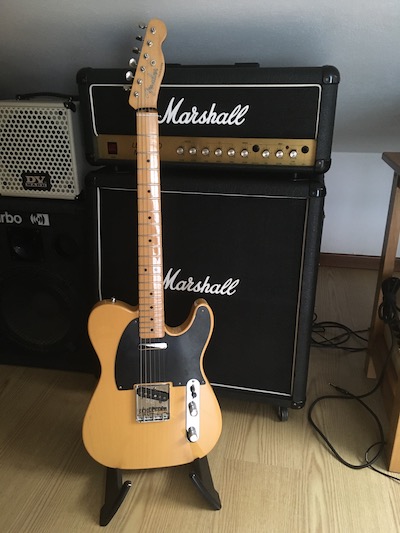
On the other hand, the clean channel is a distinctive trait of the real Marhsall, albeit very often underestimated: but do you really think you can use 100 W of head of those noble JCM 800 (single-channel) valves at such volumes as to be able to distort them, unless that you are not in a stadium (or do not have a master volume, but there are always limits there …)?
The distorted channel isn’t bad, but it doesn’t drive me crazy. It has a nice sound and I’m not saying it doesn’t deserve to be used, but when I compare it with the effects I have (like the Xotic SL Drive) objectively there is no comparison. If you use effects, not necessarily expensive, of a good level, in my opinion it is not worth it to use the distorted channel of the amplifier, simply because, it is not up to par.
Same thing goes for reverb. In my pedalboard I use a Zoom MS-50G, which certainly doesn’t excel at distorted sounds, but which is fantastic for modulations. And programmable.
A single note goes to the volume. It pushes really hard: keeping the Marshall 3210 at flat volumes is not at all trivial, as soon as you raise the master volume or that of the single channel slightly, you have an incredible boost of power. But in fact, 100 W is no small thing.
To get an idea of the sound, both clean and distorted, you can take a look at this video (and I dare you to say that the clean channel doesn’t sound divine):
Otherwise there are the videos of Johan Segeborn, a true Marshall a mosfet enthusiast. In this he presents the Marshall 5100 100W:
Conclusions
The Marshall 3210 (or lead 100) with its 1965a cabinet is practically the mosfet reproduction, with slightly reduced dimensions, of a Marshall JCM 800.
Two channels, one clean, crystal clear, extremely dynamic and perfect for twanging any guitar, which eats the input pedals very well, and a distorted channel.
Its Marshall 1965a cabinet is perfect in combination with the Marshall 3210 head, and as a whole as a room amplifier it is perfect, and also for chamber (although it has a great volume).
Used (new obviously they don’t anymore) I bought it used for 400 euros, together with the matching speaker, but it is possible to buy both the head and the speaker separately. There aren’t many, but there are some for sale anyway. On music market or reverb.com you will find some bargains.
So, is it worth it? For me absolutely yes, especially if you don’t have a huge budget but want a great sound to carry around without breaking your back, but with all the aesthetic appeal of a JCM 800 with its cabinet, at a much lower weight and without everything. the maintenance a real tube amp requires.
Published on musicanza.it on: 11/04/2022.
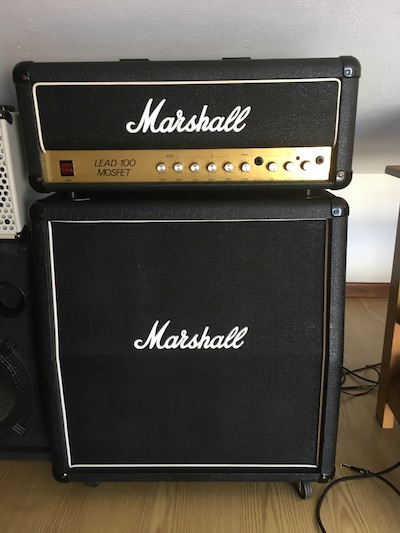
6 Comments
Add yours
OSCAR CANTERO
Lo pones en la salida de amplificador a 16ohms, al gabinete de 8ohms??
Redazione
Tu puedes poner a la salida del amplificador de 16 ohmios, en el gabinete de 8 ohmios, PERO (MUY IMPORTANTE!!!) obviamente debe tener mucho cuidado de no entregar toda la potencia del amplificador o quemar el caso. Póngalo a un máximo de 1/4 de la potencia para ser relativamente seguro…
You can put the 16 ohm amplifier output into the 8 ohm cabinet, BUT (VERY IMPORTANT!!!) you must obviously be very careful not to deliver all the power to the amplifier or burn out the case. Set it to a maximum of 1/4 power to be relatively safe…
Oscar Cantero
Y SI EL GABINETE DE 8 OHMS LO PONGO A LA SALIDA DE 4OHMS DEL AMPLIFICADOR QUE PASARIA?
Redazione
En teoría nada, lo importante es que el altavoz que conectes a la salida de un cabezal o amplificador tenga una resistencia siempre mayor o igual a la del amplificador.
En definitiva, el dato escrito en el amplificador es la resistencia mínima que debe tener un altavoz.
Si el altavoz tiene menos resistencia, aumentar el volumen del amplificador por encima de la mitad corre el riesgo de romperlo.
Si el altavoz tiene una resistencia mayor, aunque aumentes el volumen del amplificador al máximo, no vibrará lo suficiente como fue diseñado, haciéndolo menos efectivo.
Actually nothing, the important thing is that the speaker you connect to the output of a head or amplifier has a resistance that is always greater than or equal to that of the amplifier.
In short, the data written on the amplifier is the minimum resistance that a speaker must have.
If the speaker has less resistance, increasing the volume of the amplifier above half risks breaking it.
If the speaker has a higher resistance, even if you increase the volume of the amplifier to maximum, it will not vibrate enough as it was designed, making it less effective.
OSCAR CANTERO
Lo pones en la salida de amplificador a 16ohms, al gabinete de 8ohms??
OSCAR CANTERO
Lo conectas delamplificador en 16 ohms al gabinete de 8ohms?